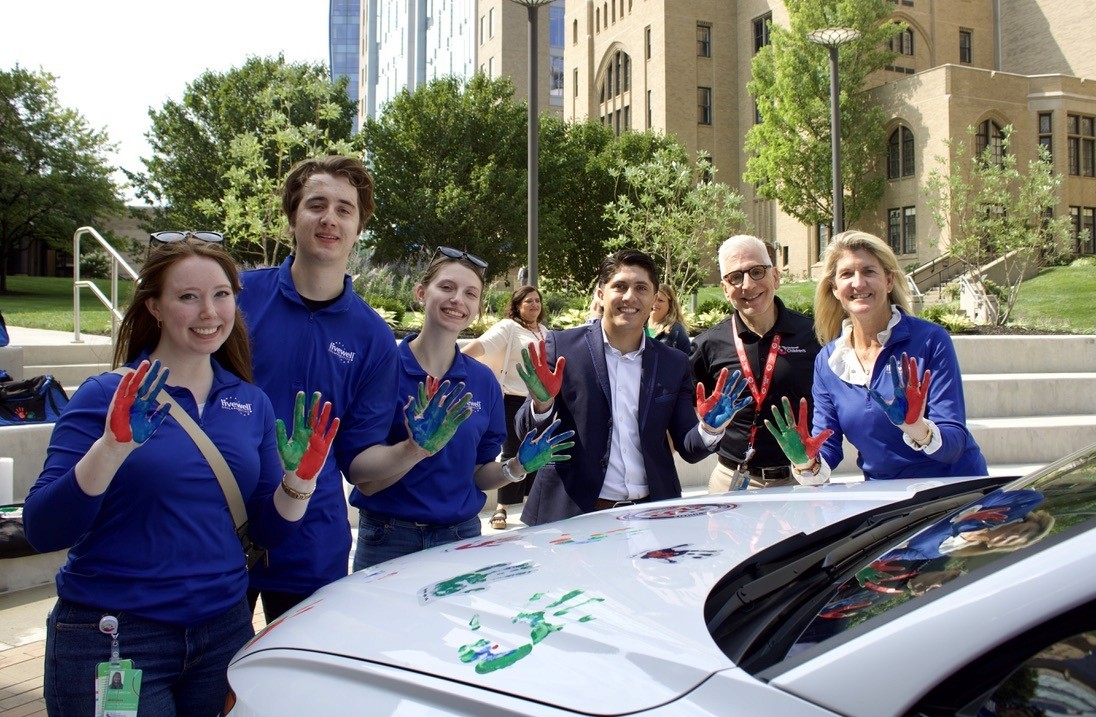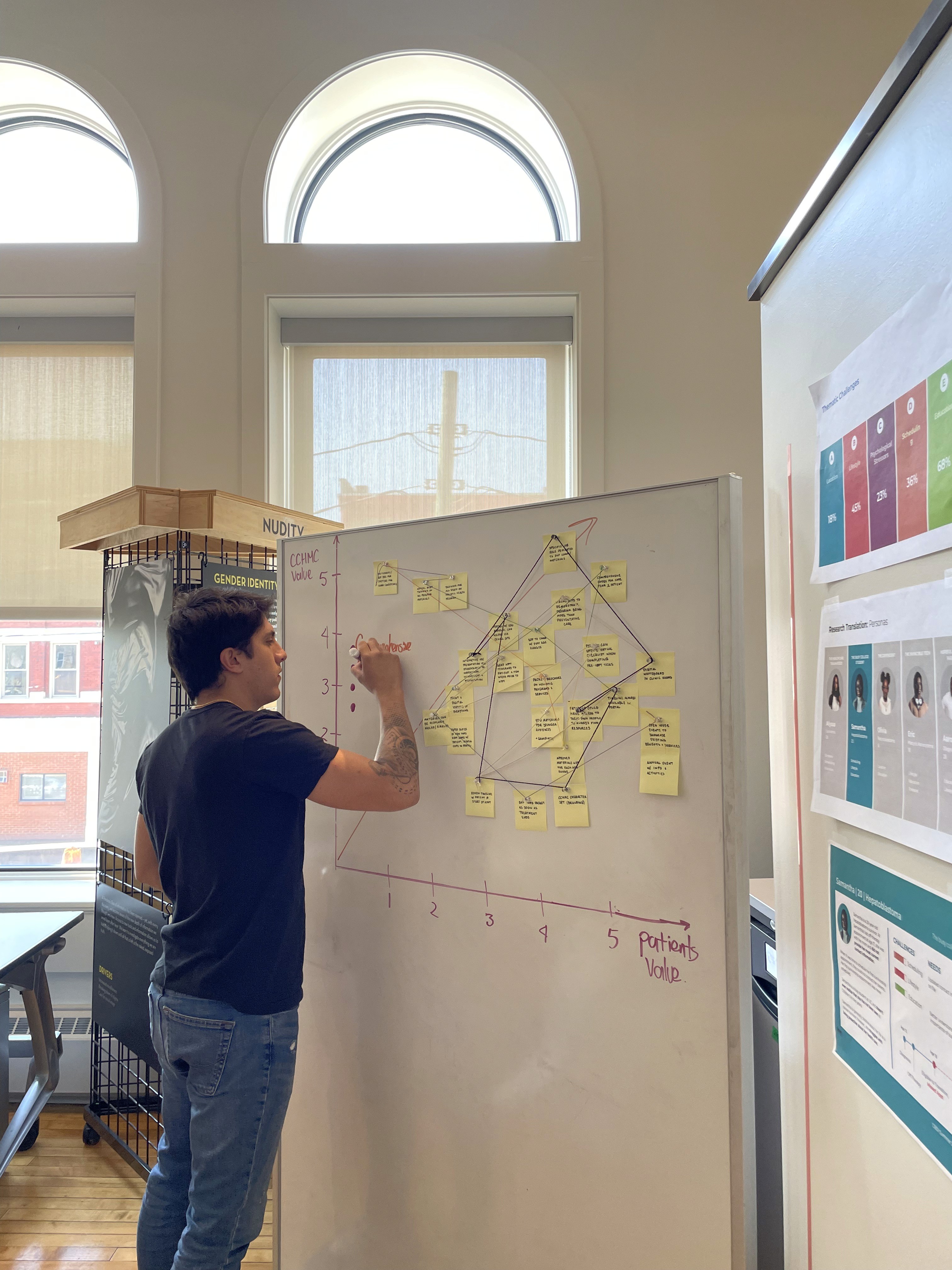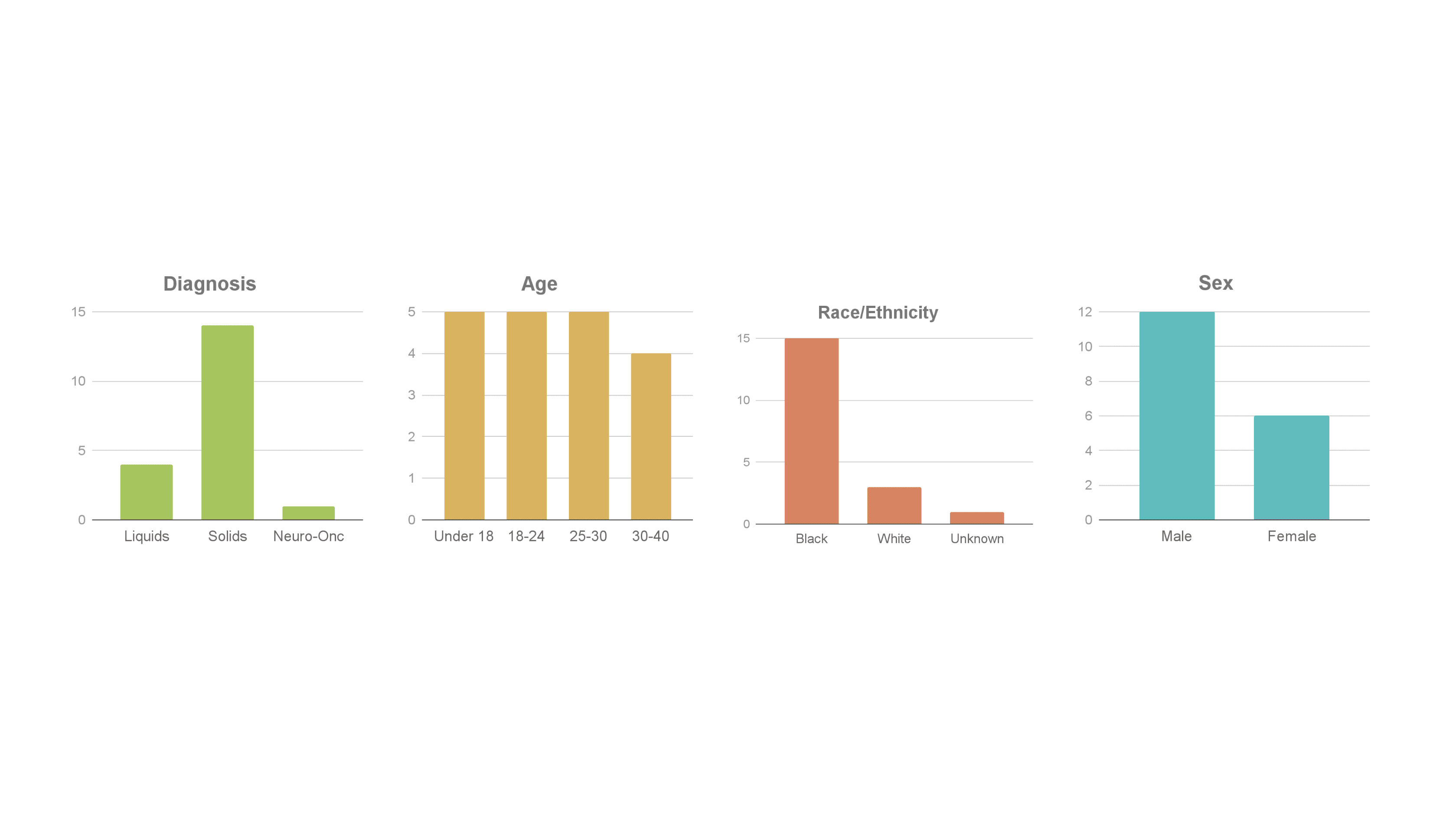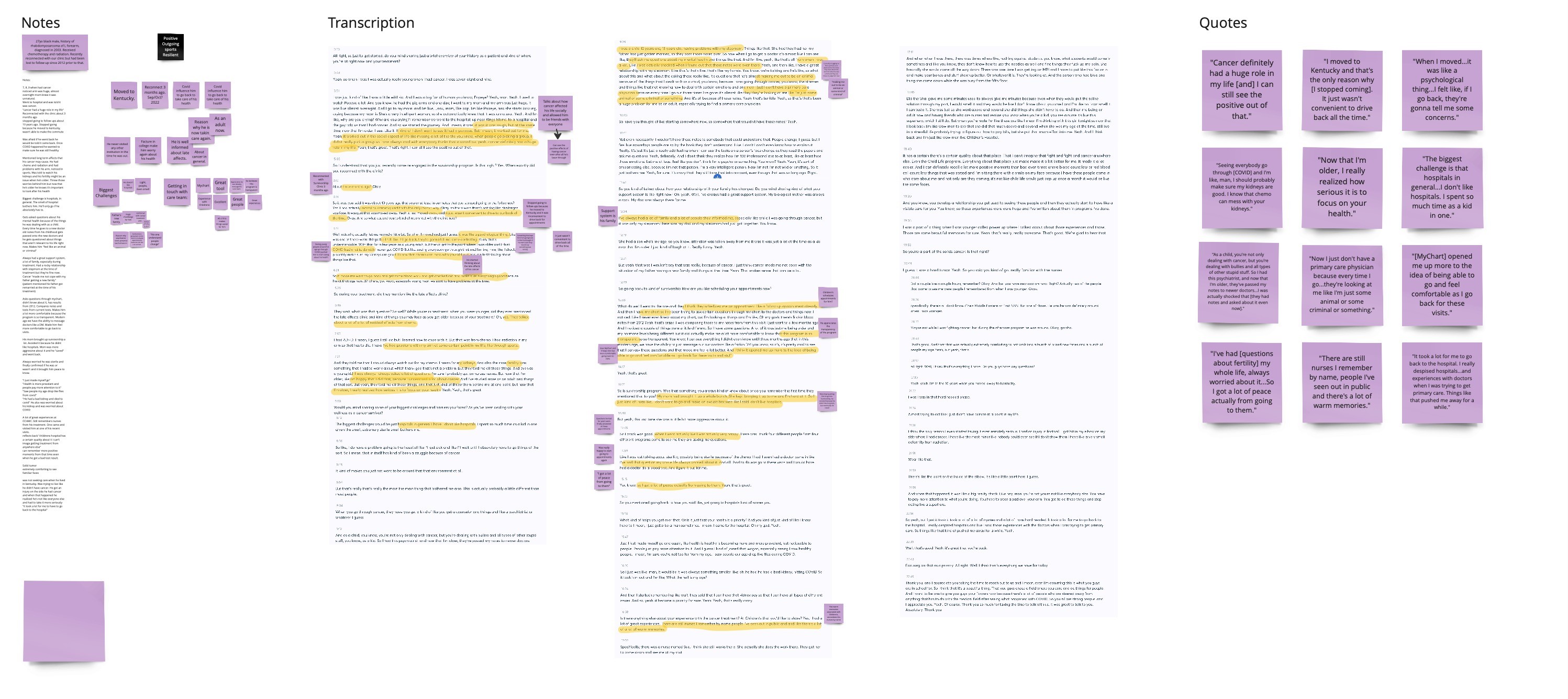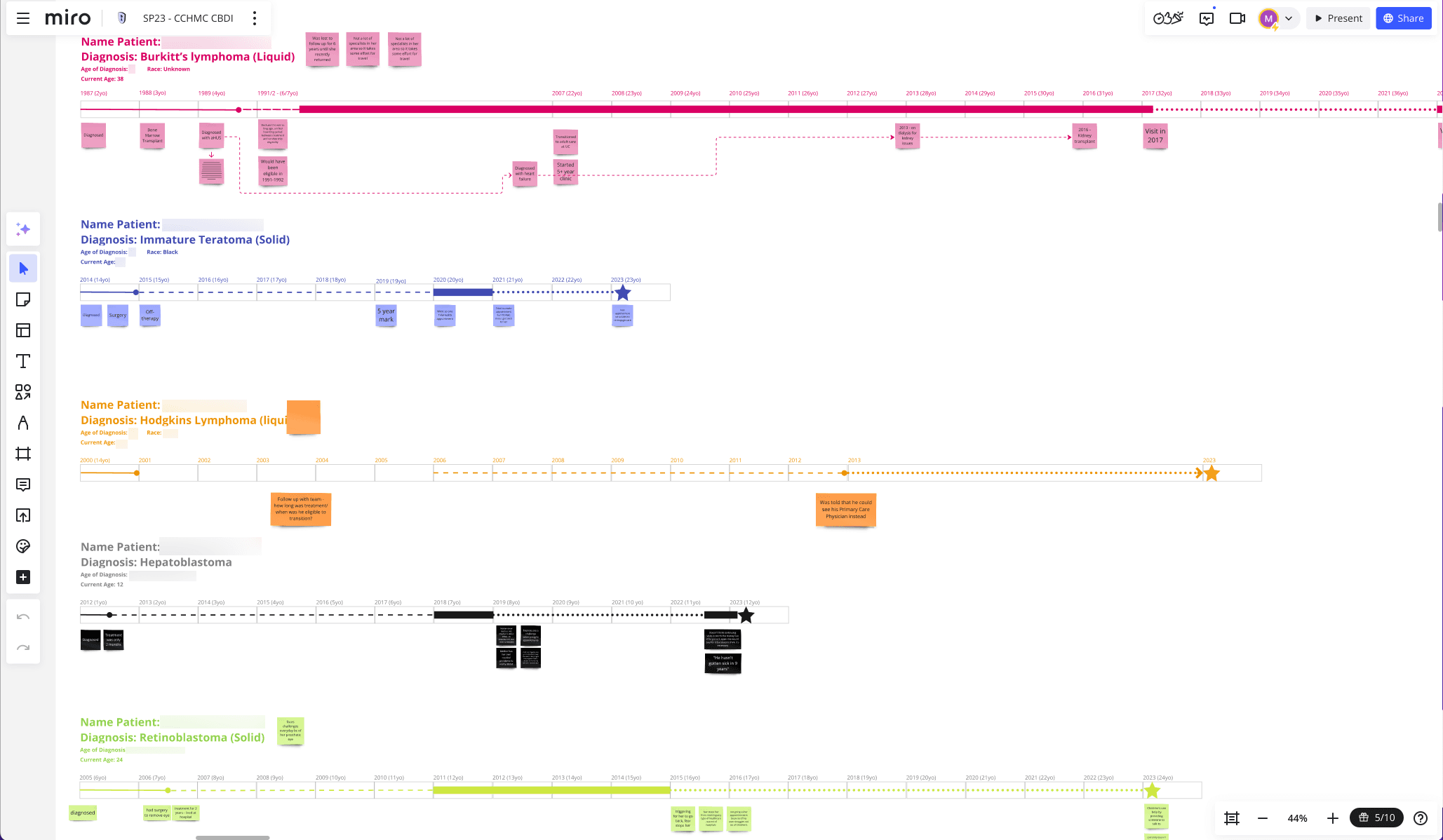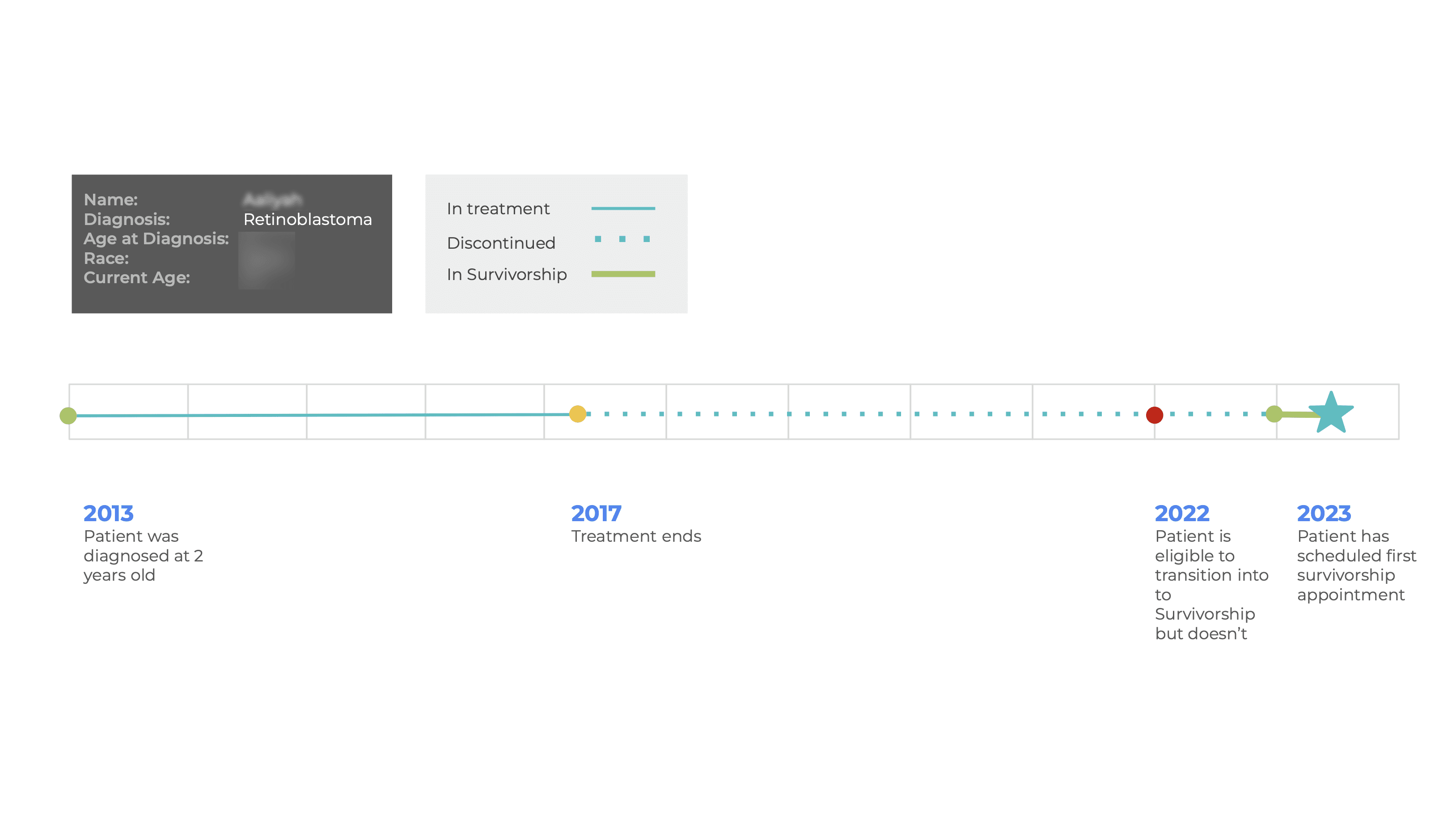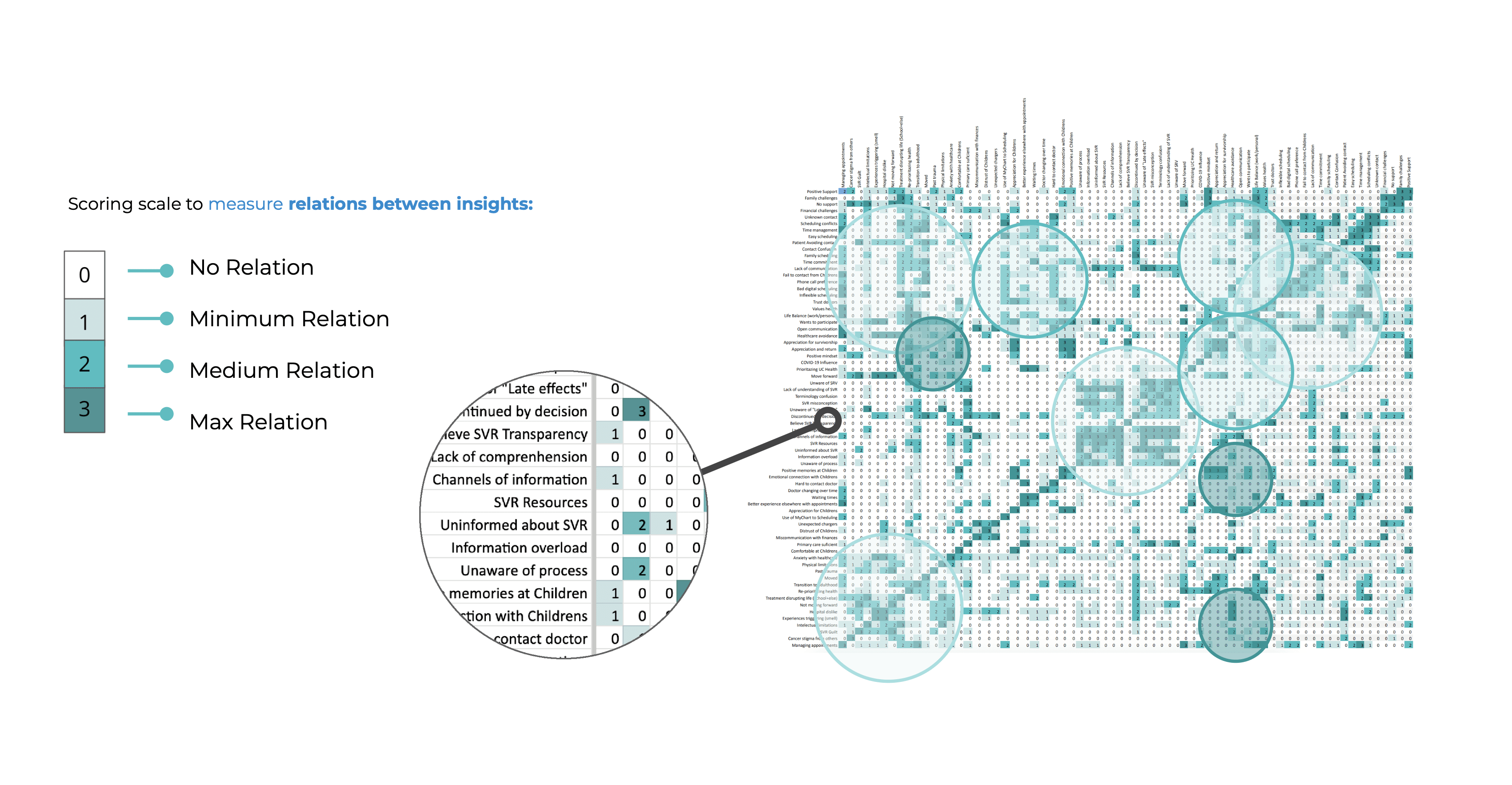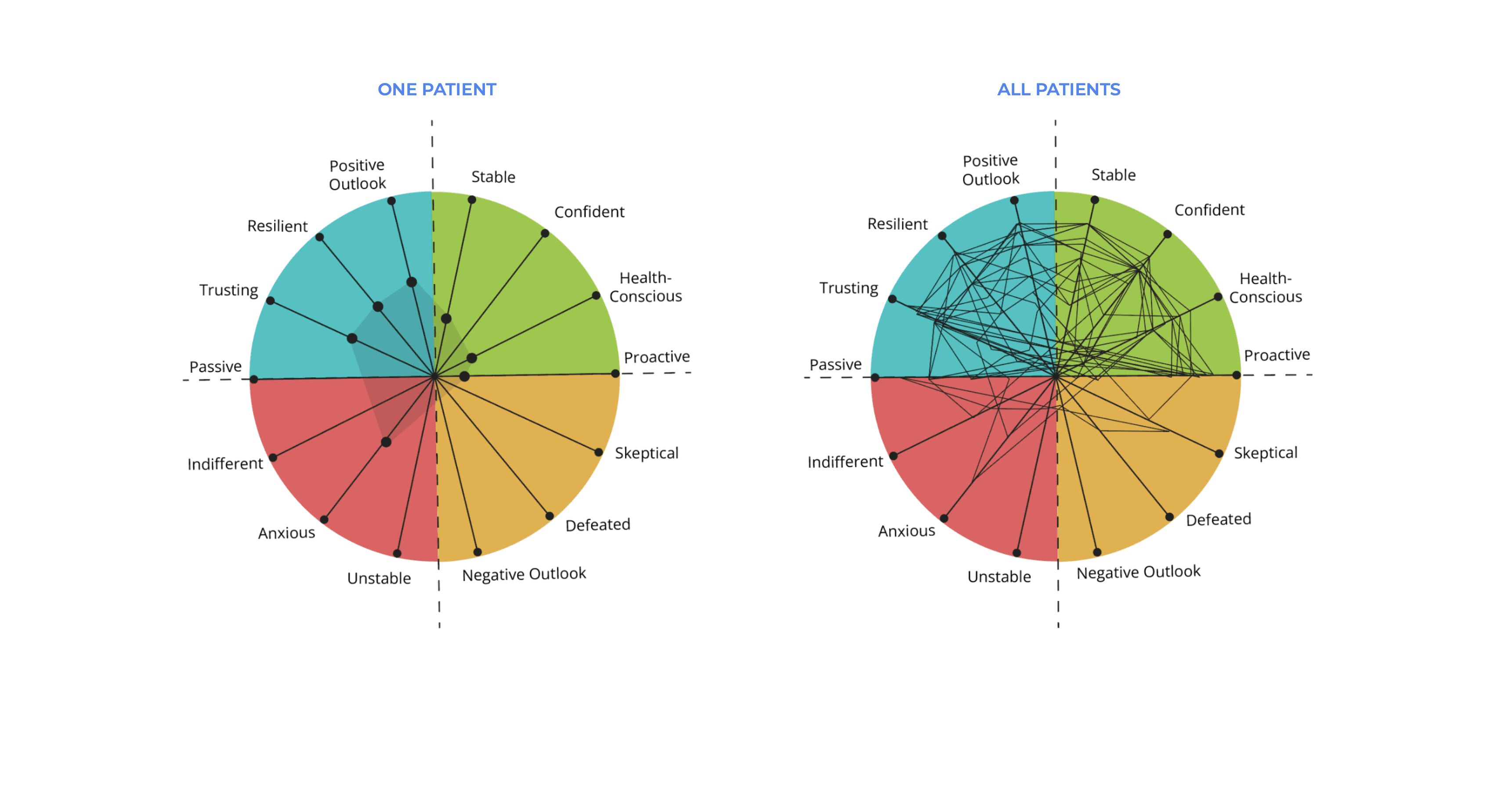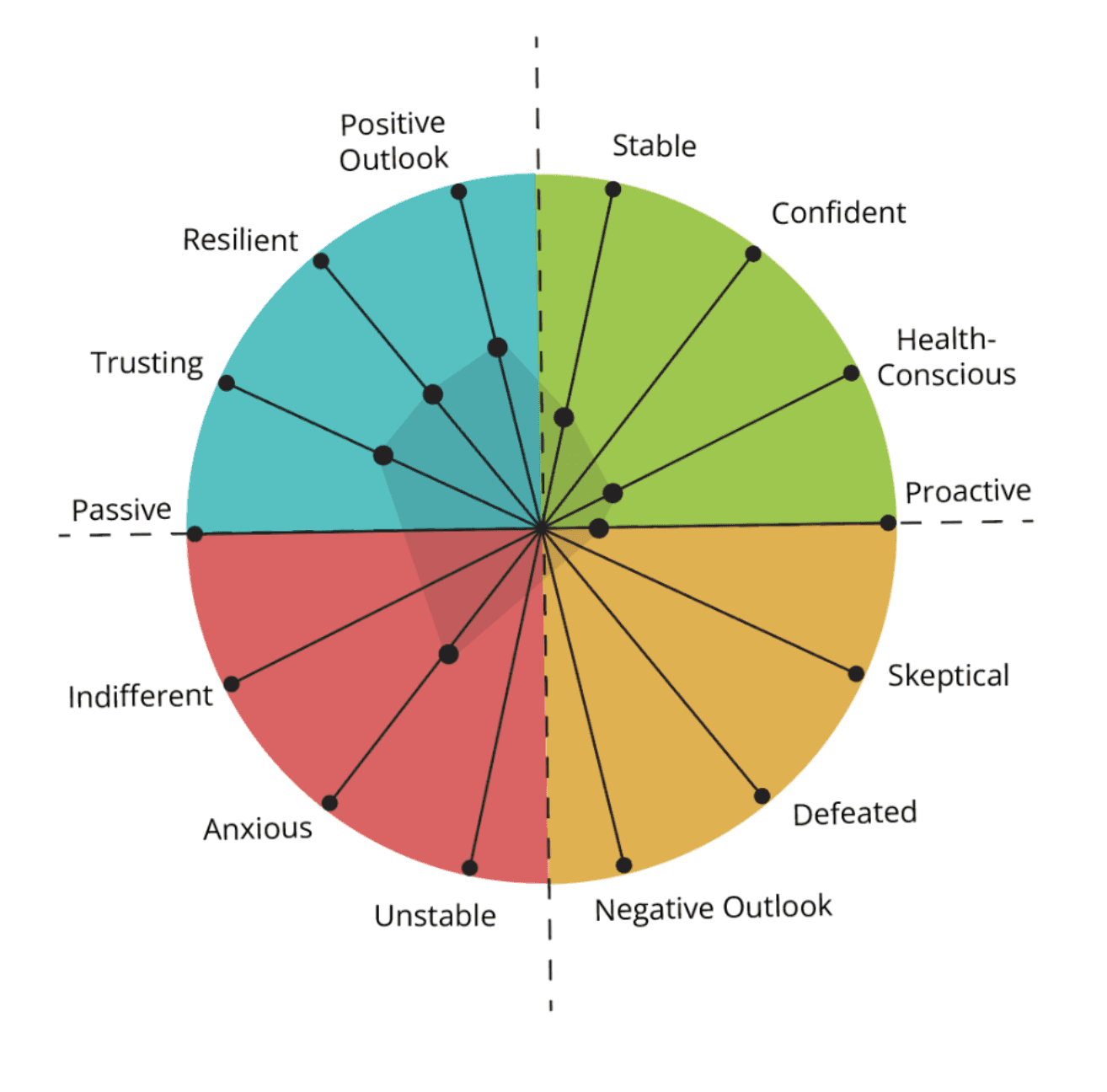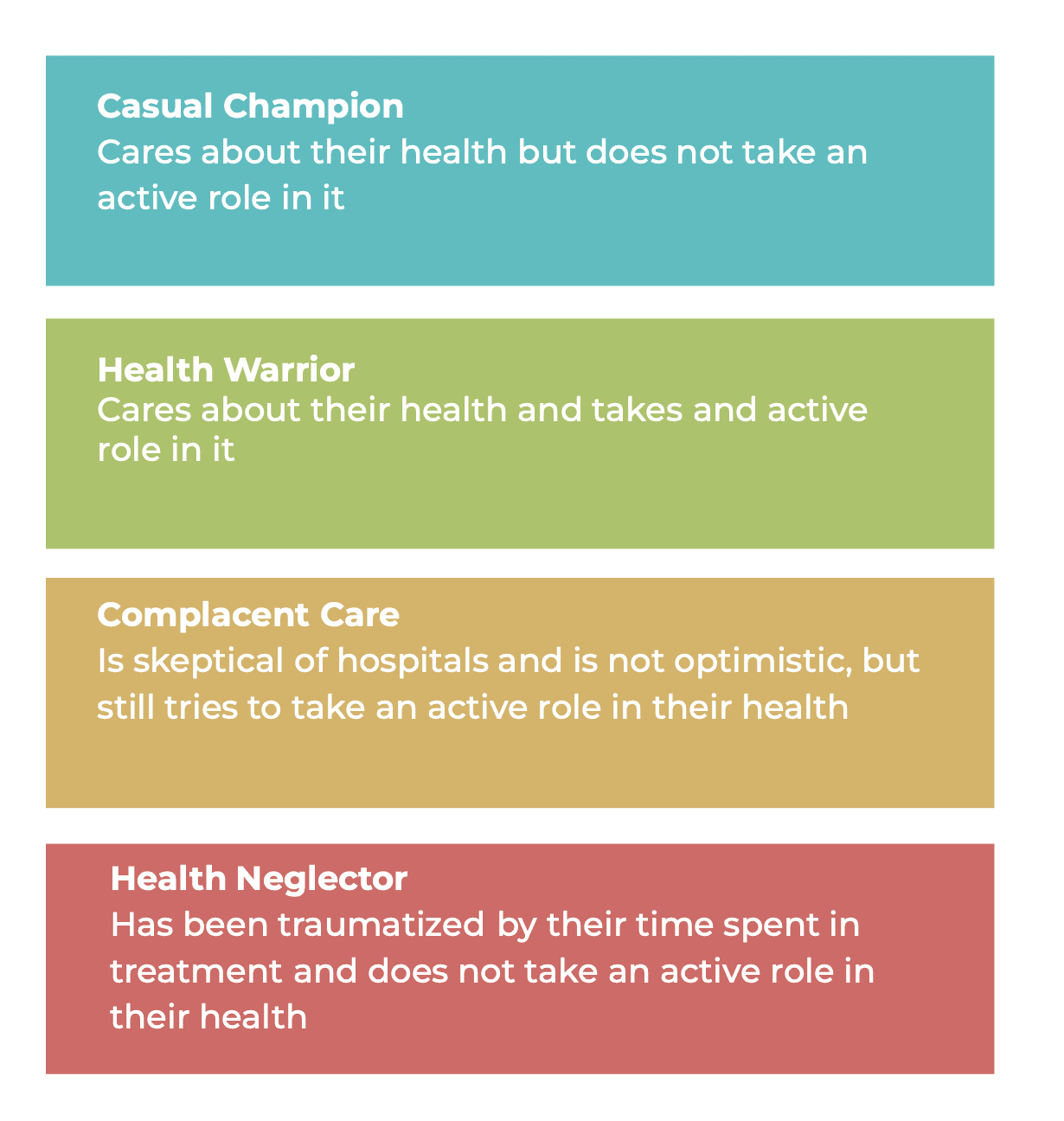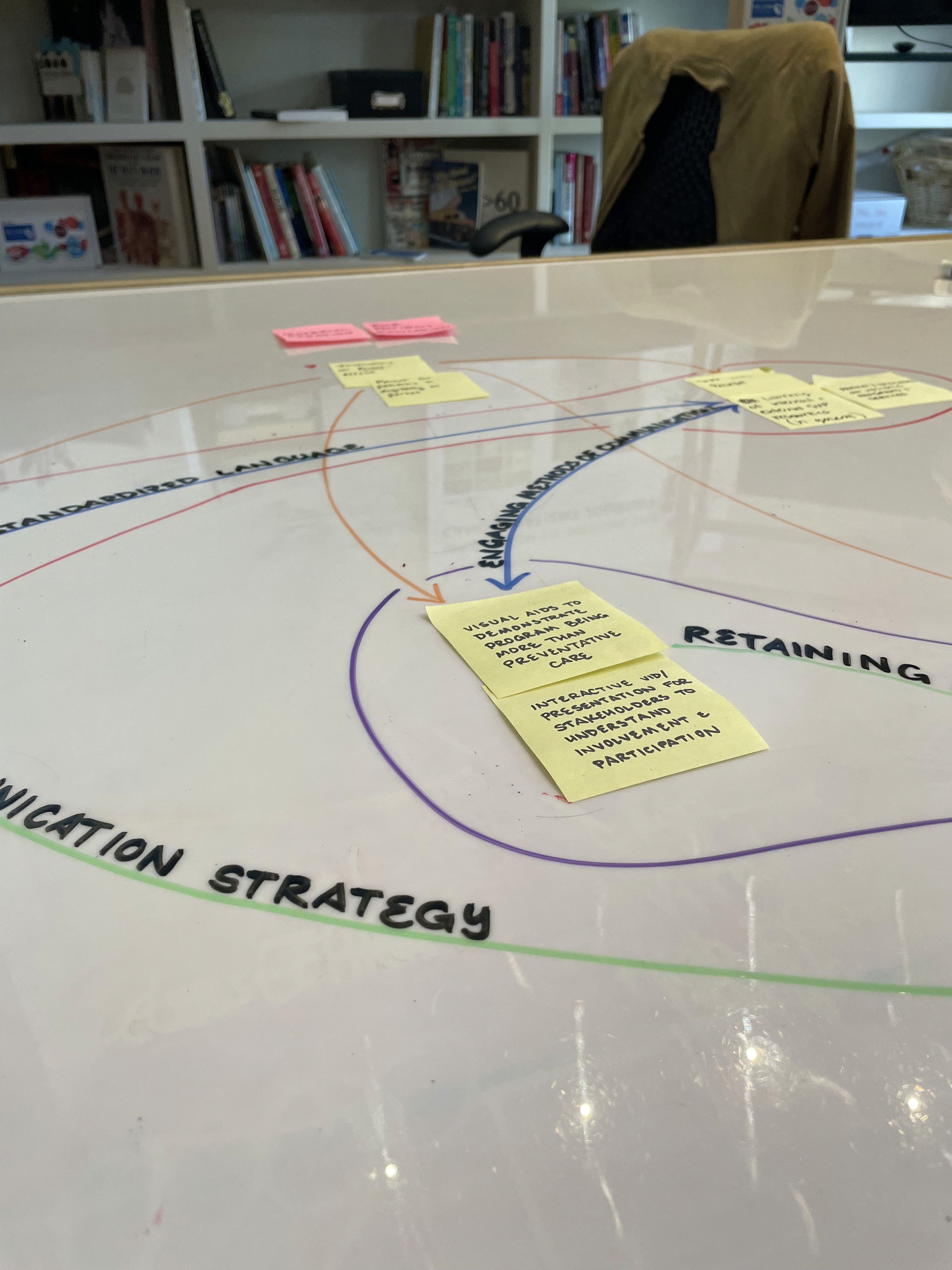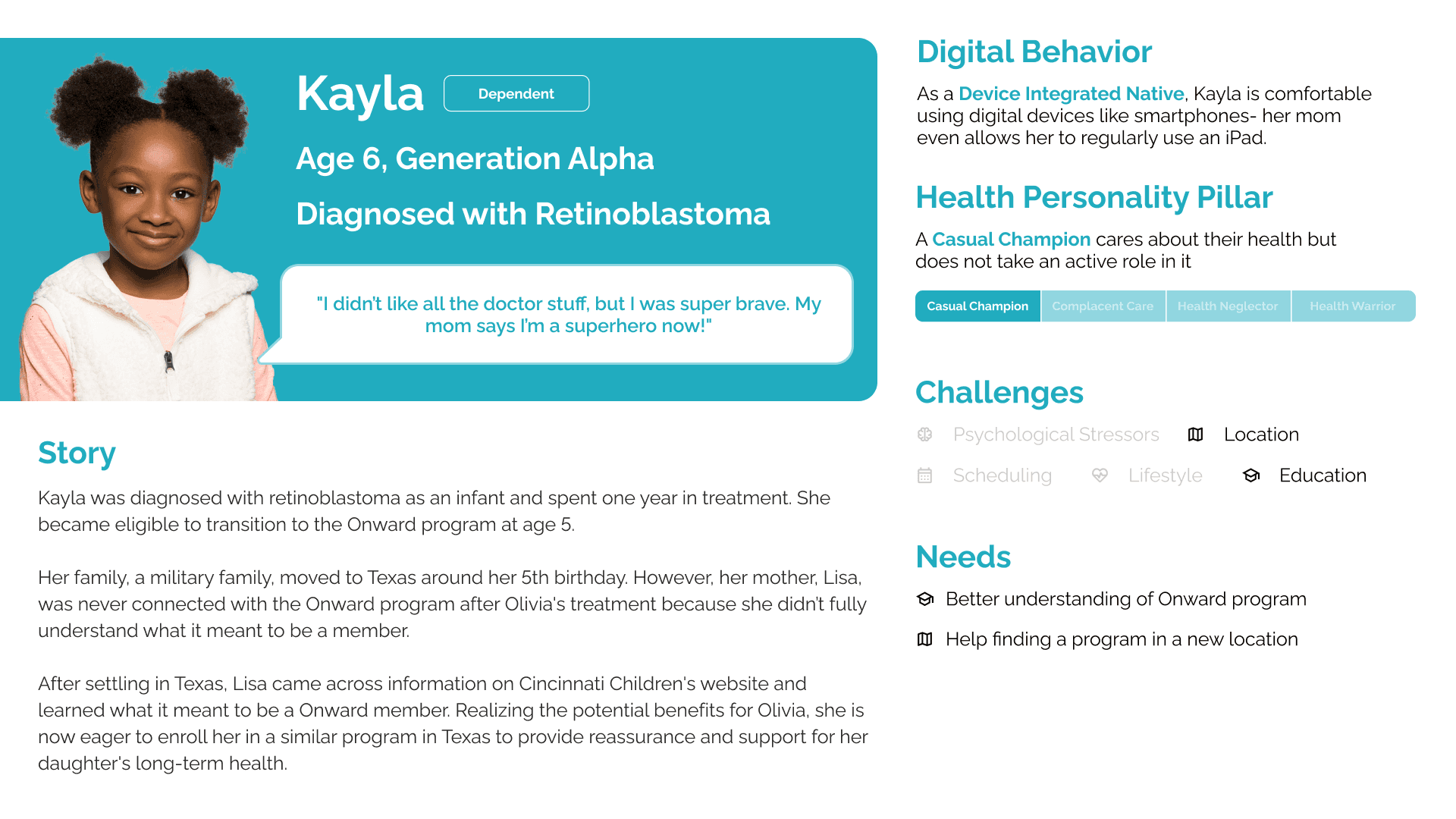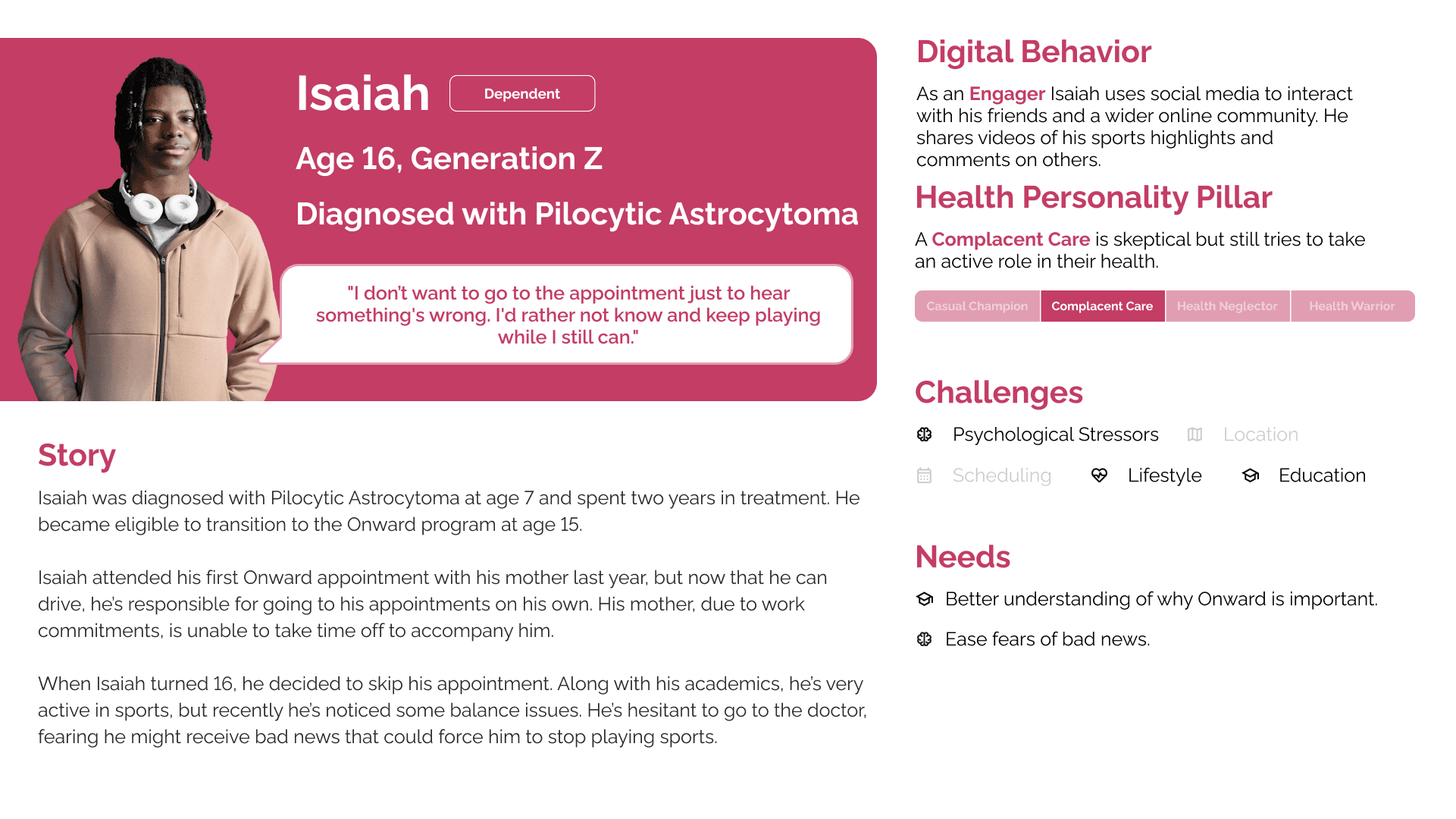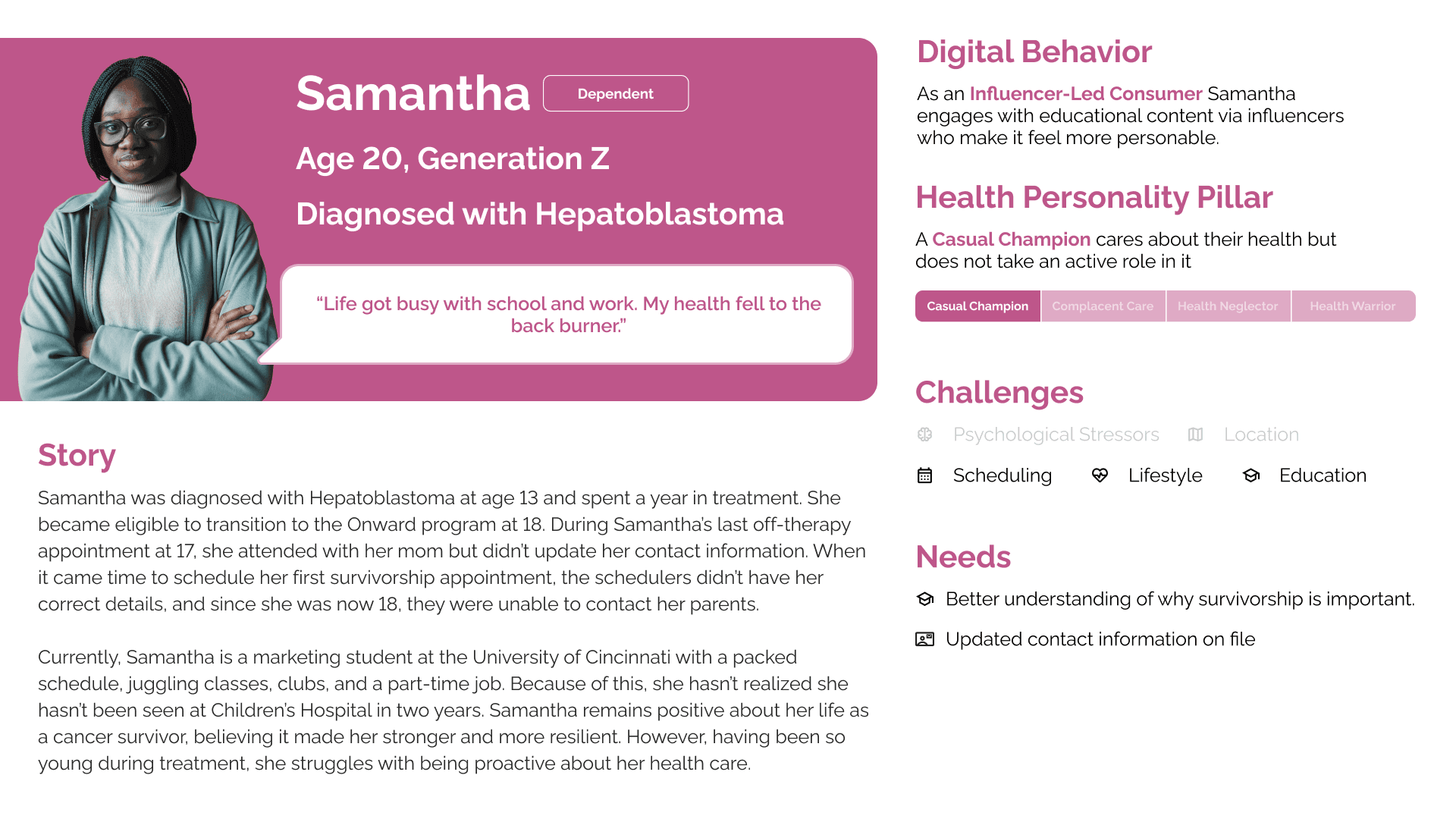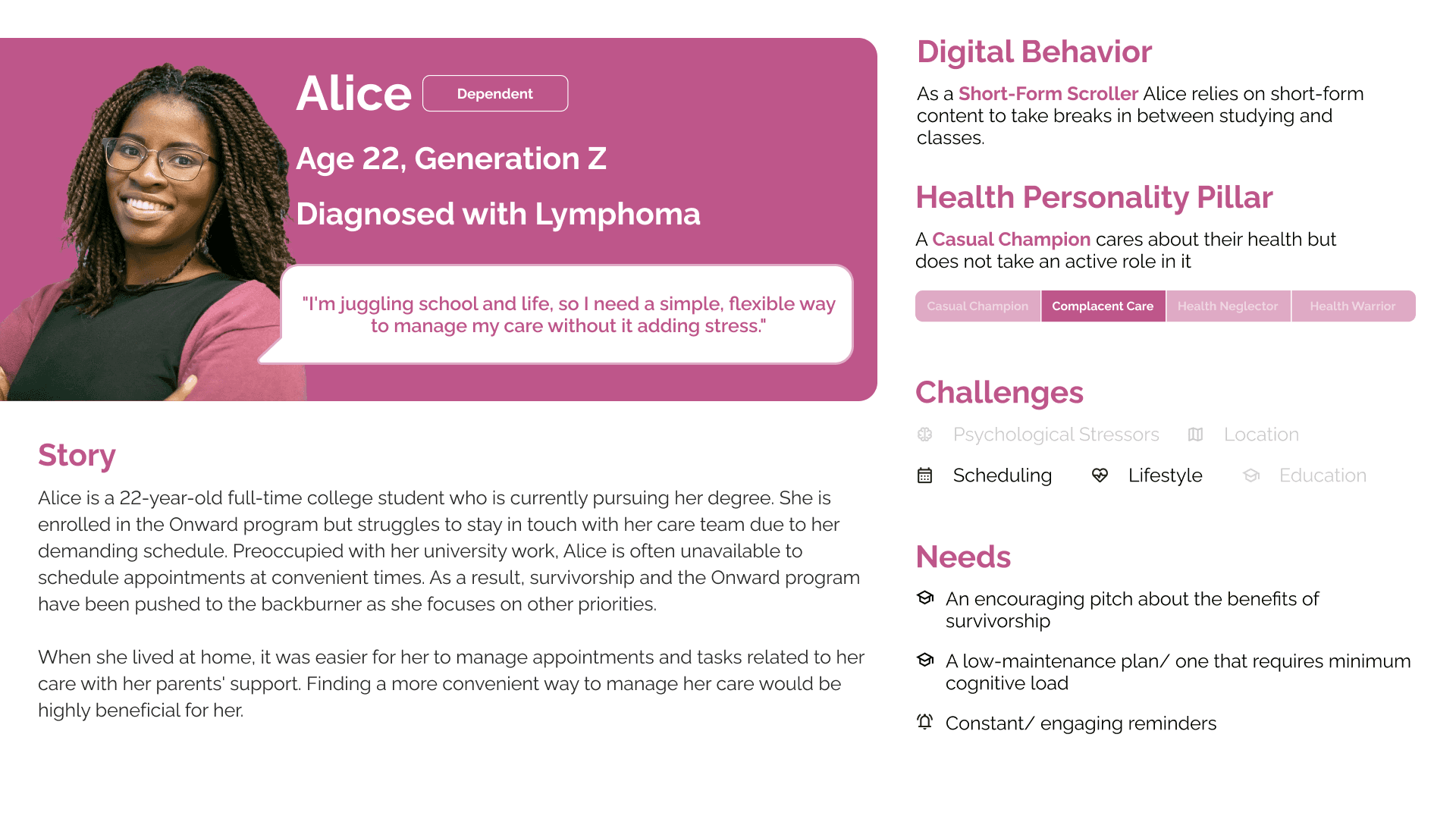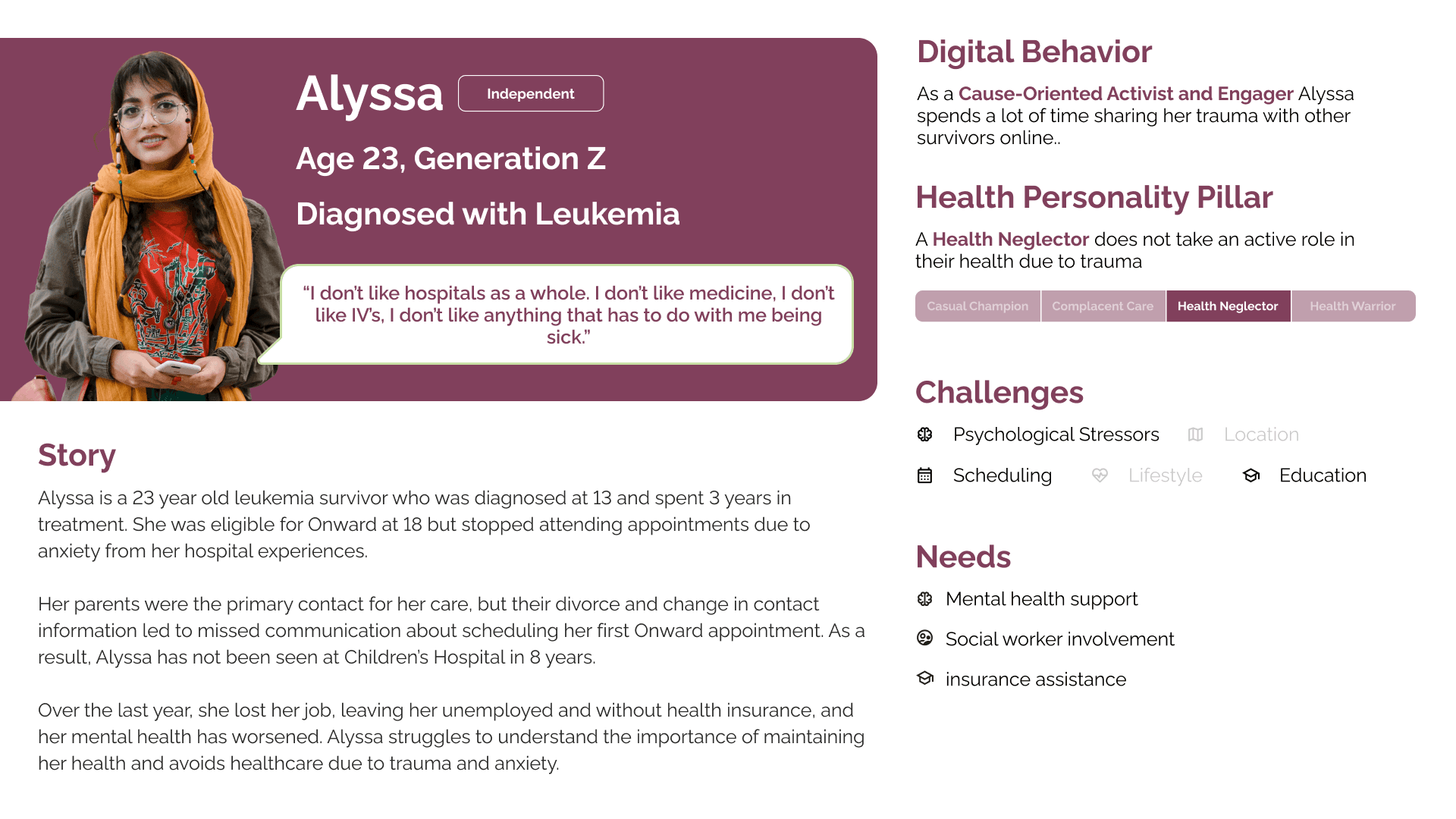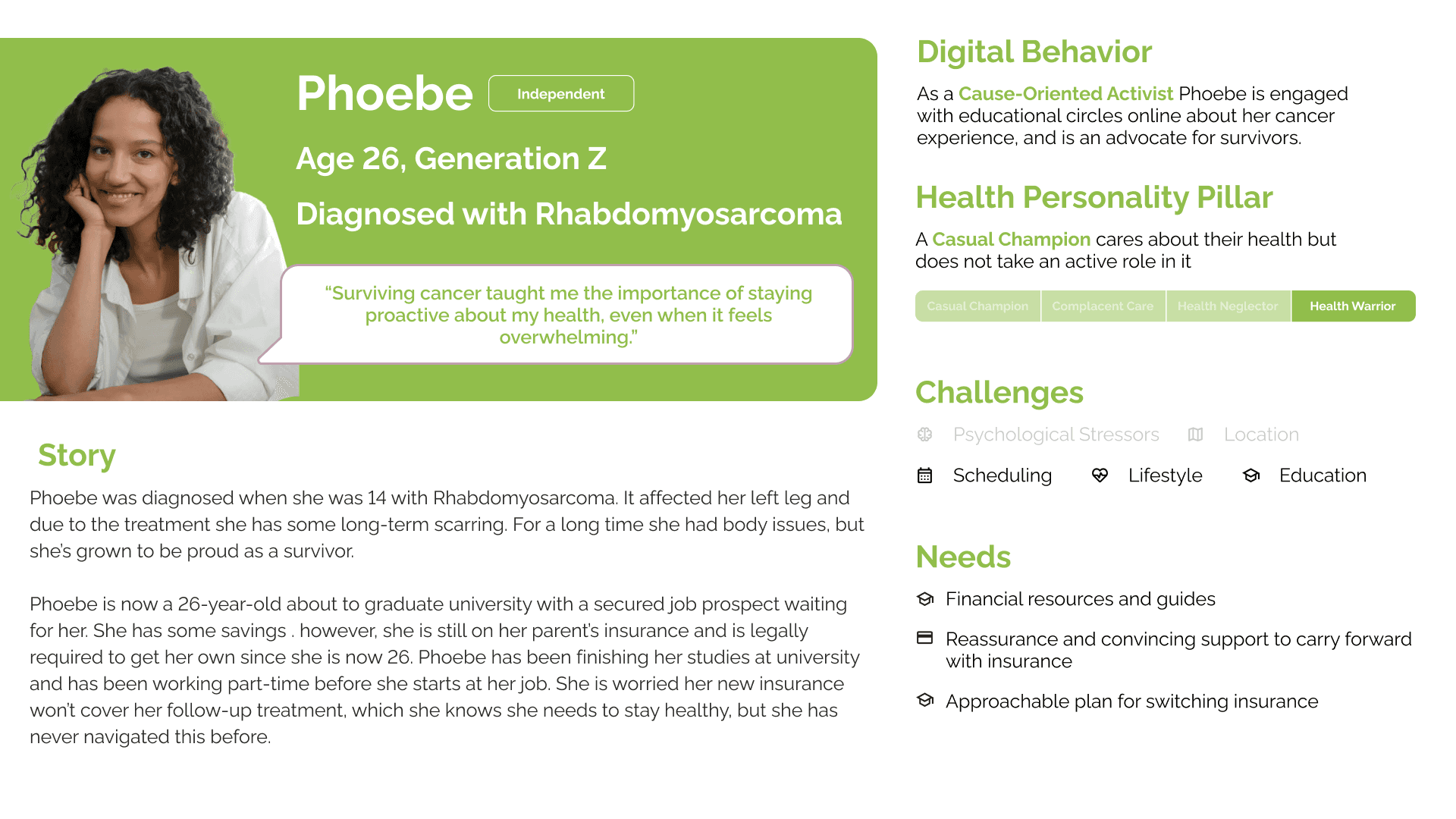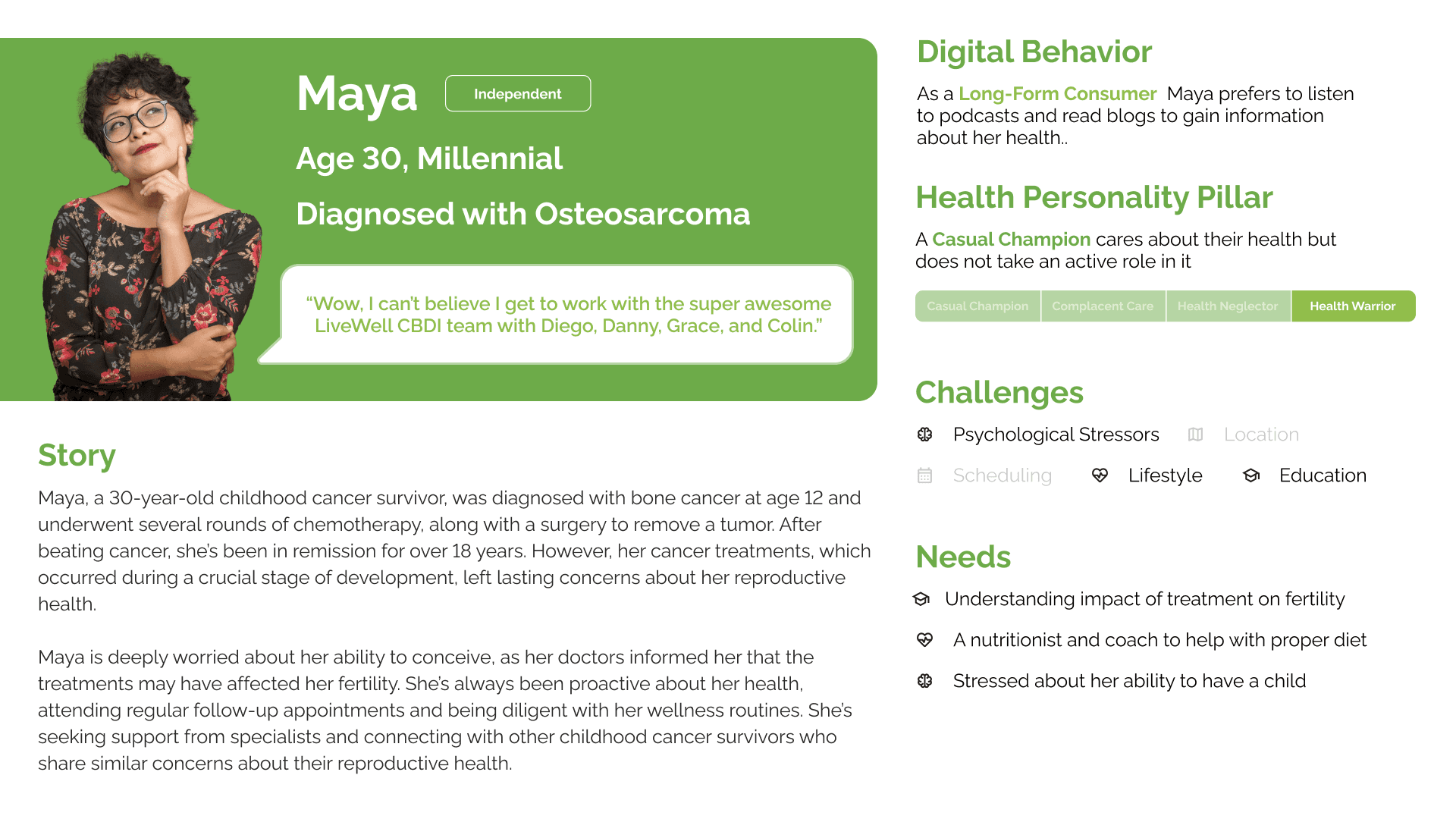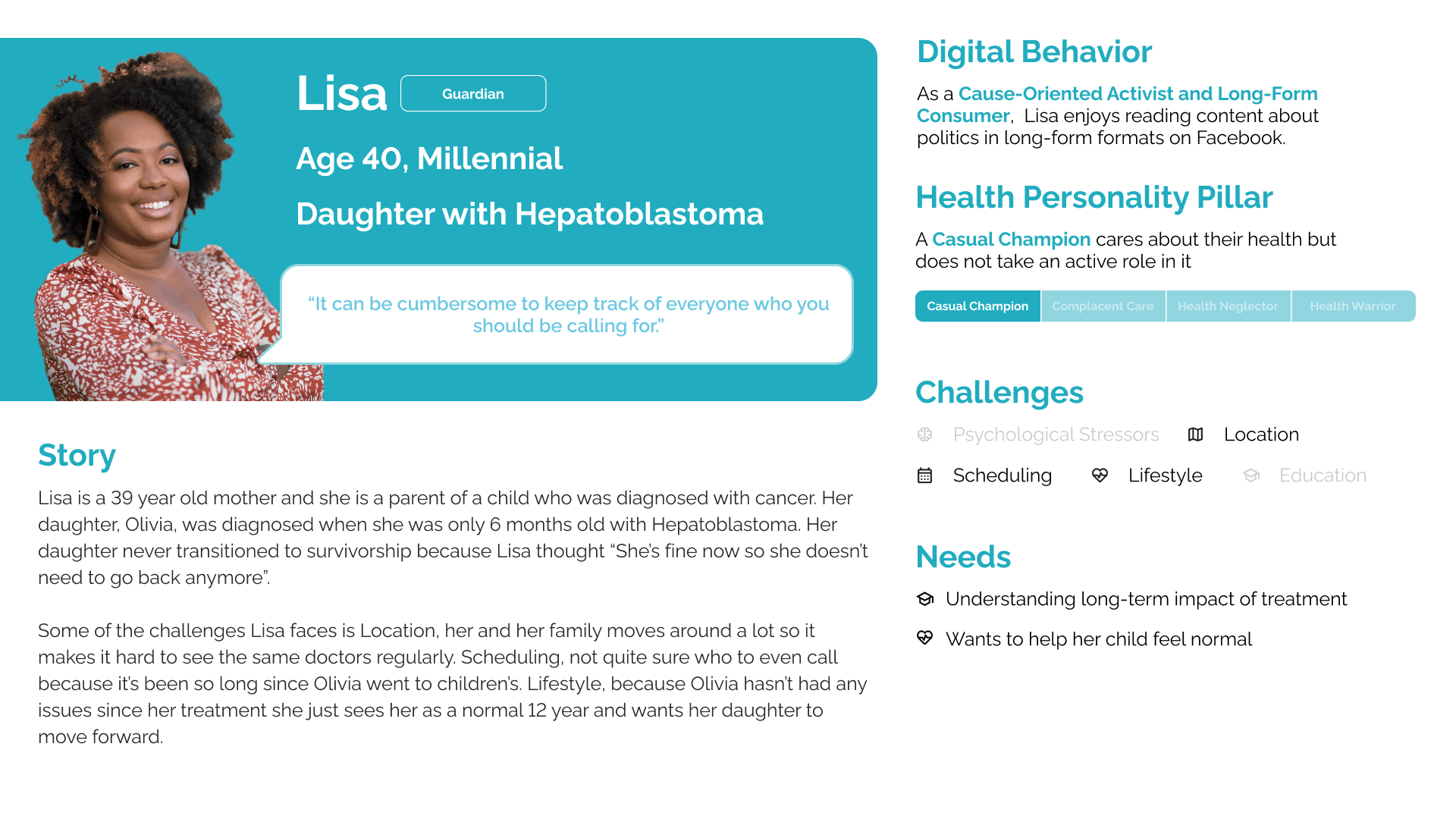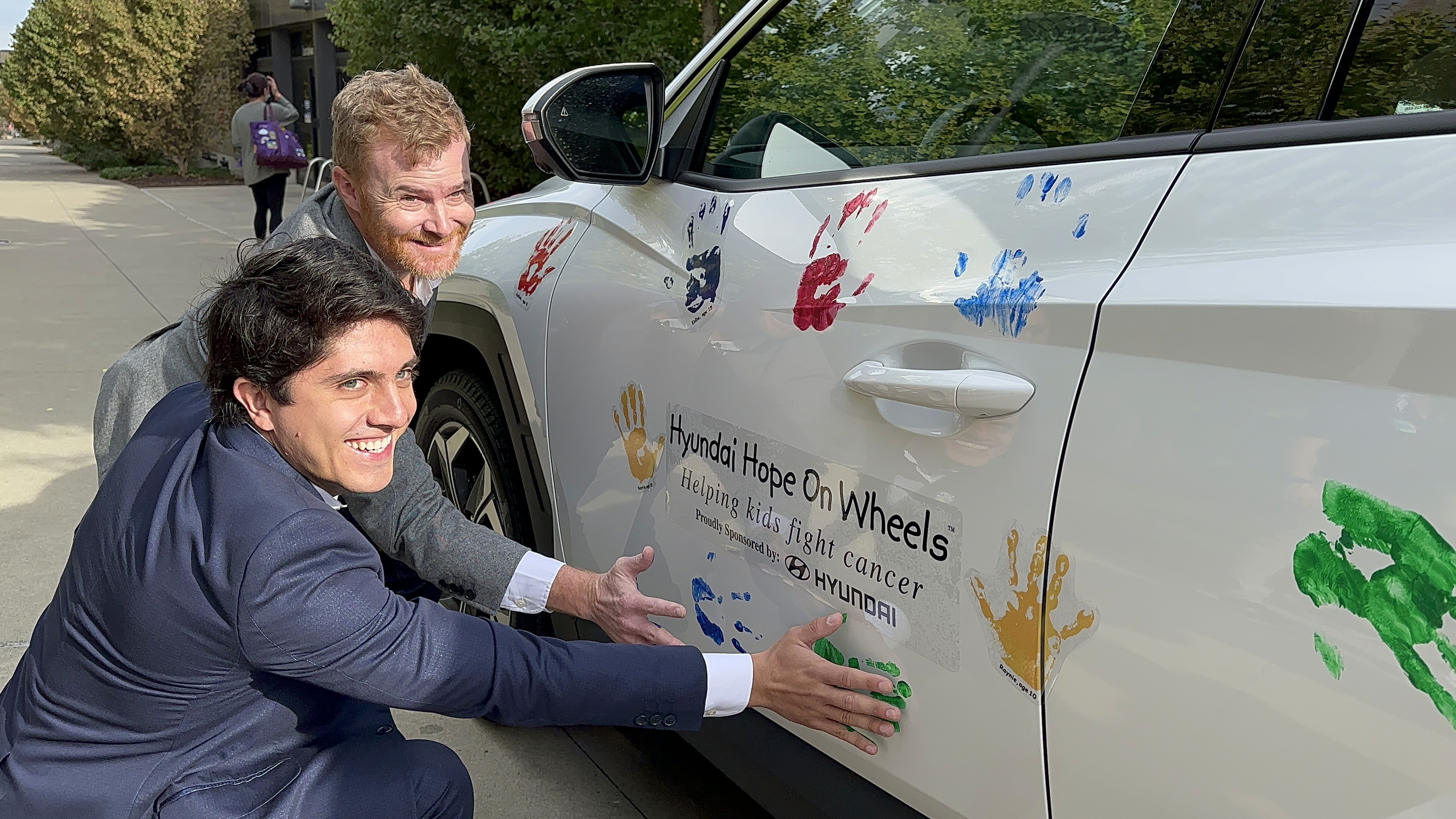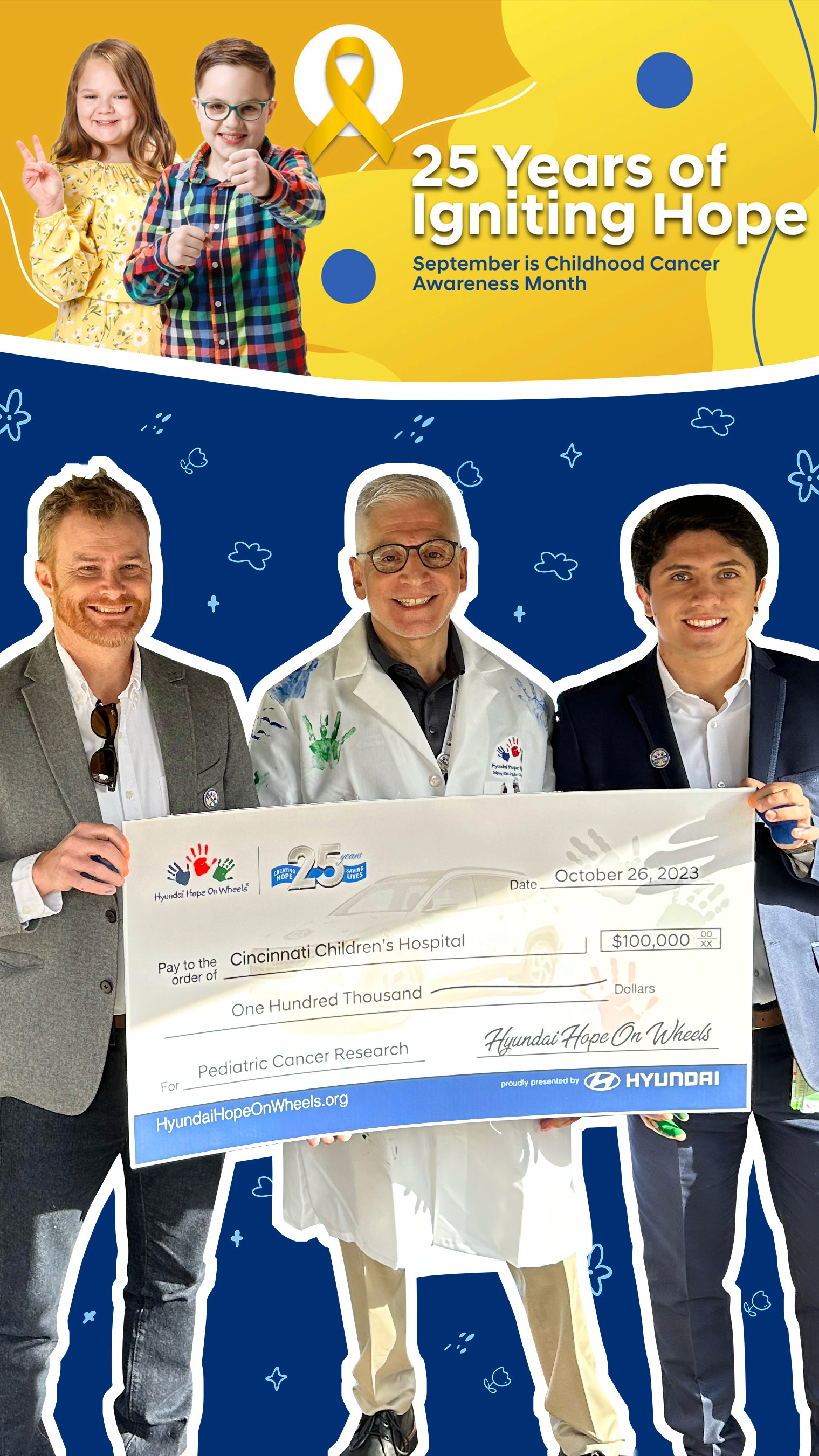Reimagining Wellness After Childhood Cancer
Human-centered UX research project focused on understanding cancer survivor patients journeys to generate empathy and build a comprehensive model for survivorship care.
Cincinnati Children's Hospital Medical Center + The Live Well Collaborative
Healthcare
Role
UX Design Research Faculty Lead
Hyundai Impact Grant Award
Jan 2023 - Dic 2023
Challenge
This research project seeks to uncover the factors influencing the transition rate of patients from active cancer treatment into the Cancer Survivorship Center, a critical phase in the continuum of cancer care. Cancer survivorship marks the period following initial treatment, extending throughout a survivor's life, and involves managing a complex array of health and psychosocial challenges. Survivors of pediatric cancer are especially vulnerable to "late effects"—health complications that may emerge years after treatment concludes. These can include cognitive difficulties, fertility issues, cardiac irregularities, lung disease, and even secondary cancers, such as early-onset breast cancer. By investigating the variables impacting the shift to survivorship care, we aim to enhance patient support, mitigate health risks, and optimize outcomes for those who have overcome childhood cancer.
Results
We are excited to announce that our research has received continued funding! Hope On Wheels, a nonprofit dedicated to helping children fight cancer, supports this mission by funding groundbreaking research, raising public awareness, and fostering discussions around pediatric cancer. In August 2023, the Cancer and Blood Disease Institute at Cincinnati Children’s Hospital Medical Center was awarded the prestigious Hyundai Hope On Wheels Impact Grant. This grant is a vital resource for pediatric cancer research nationwide, and we are honored to contribute to advancing care for young cancer patients as part of this initiative.
#1
Cancer Program in the Nation
2
Hyundai Hope on Wheels Grant Awards
Research Methods
Patients Interviews: Conducted total 19 interviews from a diverse range of diagnosis, age, race, and sex. These interviews provided authentic insights into the various challenges faced by cancer survivorship patients + families.
Patient Timelines: Individual timelines were created to document and understand each patient’s unique journey, as well as to uncover patterns amongst different patients.
Insights Clustering: Insights from interviews were organized into thematic clusters, revealing additional patterns amongst patients.
Insights Clustering Matrix: Research insights were organized into a matrix, reaffirming the themes and strengthening our findings from the clustering exercise.
Spider Graphs: Spider graphs of each patient’s personality helped display data across multiple different axises.
Archetypes: After creating the spider diagrams we evaluated the patient’s personalities and divided them into four distinct archetypes: Health Warrior, Casual Champion, Health Neglector, and Complacent Care.
Patients Interviews: Conducted total 19 interviews from a diverse range of diagnosis, age, race, and sex. These interviews provided authentic insights into the various challenges faced by cancer survivorship patients + families.
Each interview focused on understanding the unique timeline of each patient's cancer journey. The interviews were then analyzed to extract insights from various patient experiences, both in terms of their overall journey and their specific encounters at the clinic.
Patient Timelines: Individual timelines were created to document and understand each patient’s unique journey, as well as to uncover patterns amongst different patients.
Patient timelines helped the team to get familiar with each patient journey, cancer treatment processes and also to find overlaps or similarities between patients. This is a an example of a patient timeline. She was diagnosed with Retinoblastoma. She went for treatment until 2017 and in 2022 the patient was eligible to transition into survivorship but doesn’t. One year after, by the time we conducted this interview, the patient had schedule her first survivorship appointment.
Insights Clustering: Insights from interviews were organized into thematic clusters, revealing additional patterns amongst patients. A total of 142 insights were collected, the insights were a combination of statements, personal issues, conception about the program and more. Then we grouped them and clustered them among 10 categories, these patterns were grouped and named by defining the nature of their commonality. Some of these clusters were Understanding (regarding to the Survivorship program) or life after cancer.
Insights Clustering Matrix: Research insights were organized into a matrix, reaffirming the themes and strengthening our findings from the clustering exercise.
To score the relation between insights, the team used a scale 0 to 3. 0 means no relation between entities, 1 means minimum relation, 2 means medium relation, and 3 means maximum relation. Scoring was done as a team to reduce biases and get to as objective a score as possible.
To accurately and effectively describe the different patient clusters that were identified, our team carefully named each cluster based on their defining characteristics. The clusters were classified in three categories according to the levels of concentration and hierarchy, each represented by their distinct color: light blue, medium blue, and dark blue:
The categories that we were able to identify where: Light blue, with the highest hierarchy, we have the barriers the patient has to deal with: Scheduling + Life Balance, Anxiety and how it leads to distrust, insights regarding Scheduling variables, and the misconception of the Survivorship program.
On medium blue, in mid level, we have the positive side: the importance of the relationship between Children's and patient, the trustiness and how it would lead to improve communication and the positive outlook on health and healthcare.
Finally in dark blue, with the lowest hierarchy but not less important: Neutral on Survivorship which means they understand and don’t have any issues,
We also found unexpected patterns that should be potentially considered in the following phases of this project which are: Trauma preventing Action, and Trauma inspiring action.
Spider Graphs: Spider graphs of each patient’s personality helped display data across multiple different axises.
Our conversations with patients were deeply authentic, giving us a strong sense of who each person was. This allowed us to gather insights that highlighted distinct personality traits for each patient. We then categorized these traits and visualized them on a spider graph spectrum, enabling us to see where each patient’s personality fell across various dimensions.
On the left, you can see an example of one patient’s placement on the graph, situated in the upper left quadrant.
On the right, we mapped all our patients on a single spider diagram, revealing a wide range of personality traits across the group. This diversity informed our next methodological steps.
Archetypes: After creating the spider diagrams we evaluated the patient’s personalities and divided them into four distinct archetypes: Health Warrior, Casual Champion, Health Neglector, and Complacent Care.
Results
The research helped identified 5 major categories. All the challenges reported by the patients we interviewed fell into at least one of these five groups.
Location
8%
Patient moved or relocated
Some patients have discontinued survivorship care is because they moved or relocated. Patients can’t keep up with appointments because it isn’t feasible to travel from different locations.
Education
36%
Lack of knowledge about Survivorship program
A lack of knowledge of the survivorship program has been the most prevalent reason for patients discontinuing their care. Most patients were unaware or had misconceptions of what the program was.
Scheduling
21%
Difficulty with scheduling appointments
Scheduling has also played a part in discontinuation, whether it be having to reschedule an appointment multiple times or not knowing who or when to schedule.
Lifestyle
24%
Some patients’ lives became too busy and their healthcare fell in priority.
Psychological Stressors
11%
Relating to hospitals or being re-diagnosed
Many patients experienced certain triggers and stressors in relation to the healthcare environment. Sometimes these stressors are too much for the patient and prevent them from continuing their care.
Personas
Based on our research findings, we synthesized the information into a set of personas. These personas help us understand and connect with the experiences of those whose lives the hospital aims to improve, providing insights that go beyond mere statistics and facts to reveal a more comprehensive view of each individual’s story.
Key objectives for these set of personas were to:
Enhance Personalization of Support Services
Understand specific emotional, physical, and social needs of each persona to tailor support services that address individual challenges during survivorship.
Identify preferred communication channels and styles for each persona to foster a sense of trust and comfort with program resources.
Optimize Health Monitoring and Follow-Up Care
Define persona-specific health monitoring needs to create targeted follow-up care protocols, ensuring timely intervention and support.
Develop clear, accessible pathways for each persona to track symptoms, manage medications, and report any health concerns, promoting proactive self-care.
Foster Community and Peer Support Networks
Design persona-driven community resources, such as support groups or mentor programs, to cultivate shared understanding and support among survivors with similar experiences.
Establish digital and in-person opportunities for social engagement that align with each persona’s lifestyle and preferences, promoting a sense of belonging.
Increase Access to Mental Health and Wellness Resources
Tailor mental health resources to address the specific emotional and psychological challenges faced by each persona, including tools for anxiety, depression, and body image concerns.
Provide wellness programs, such as mindfulness, exercise, or creative outlets, that resonate with the interests and needs of each persona to enhance their overall quality of life.
Empower Survivors Through Education and Resource Navigation
Equip each persona with easy-to-understand educational materials on post-treatment care, healthy living, and signs of recurrence tailored to their literacy and engagement levels.
Create a streamlined resource navigation system for each persona to access healthcare, financial, and social services with ease and confidence.
Build Advocacy and Self-Advocacy Skills
Support each persona in developing advocacy skills, enabling them to communicate their needs effectively within their healthcare teams and with caregivers.
Empower survivors with information on their rights, available resources, and coping strategies to navigate challenges independently and advocate for themselves throughout their survivorship journey.
Hyundai Hope on Wheels Impact Grant Award - $100.000,00
The mission of Hope On Wheels is to help kids fight cancer. They do so by funding innovative research, creating public awareness, stimulating social media conversation and serving as a thought leader.
On August 2023, thanks to our research vision, the Cancer and Blood Disease Institute at the Cincinnati Children’s Hospital Medical Center got awarded by the Hyundai Hope on Wheels Impact Grant Award that aims to contribute to pediatric cancer research across the country, and we are honored to be a part of their story!
Next Steps & Evaluation Metrics
In order to move effectively with our research, next steps include the focus on the identified challenges, and the effectiveness of our strategies in addressing these challenges.
These strategies will be evaluated before moving on to next phases. This iterative approach allows us to refine and improve the program based on feedback from patients and stakeholders.
Go to top
© Diego Gomez 2025
